Contract Law: Agents, Contractors, and Contractual Elements
VerifiedAdded on 2020/02/23
|10
|3039
|251
Essay
AI Summary
This essay provides a comprehensive overview of contract law, beginning with an explanation of what constitutes a binding contract and its essential components, including offer, acceptance, consideration, capacity, legal purpose, and mutuality. It then addresses whether a contract must be in writing to be binding, highlighting the importance of written agreements, particularly in business contexts. The essay further explores formal contracts, outlining their characteristics and providing examples. It also analyzes a scenario involving a social agreement and its implications under contract law. Finally, the essay distinguishes between an agent for a principal and an independent contractor, emphasizing the legal implications of each relationship, including their respective responsibilities and reporting structures.

Running Head: CONTRACT LAW 1
Contract Law
Student’s Name
University Affiliation
Contract Law
Student’s Name
University Affiliation
Paraphrase This Document
Need a fresh take? Get an instant paraphrase of this document with our AI Paraphraser
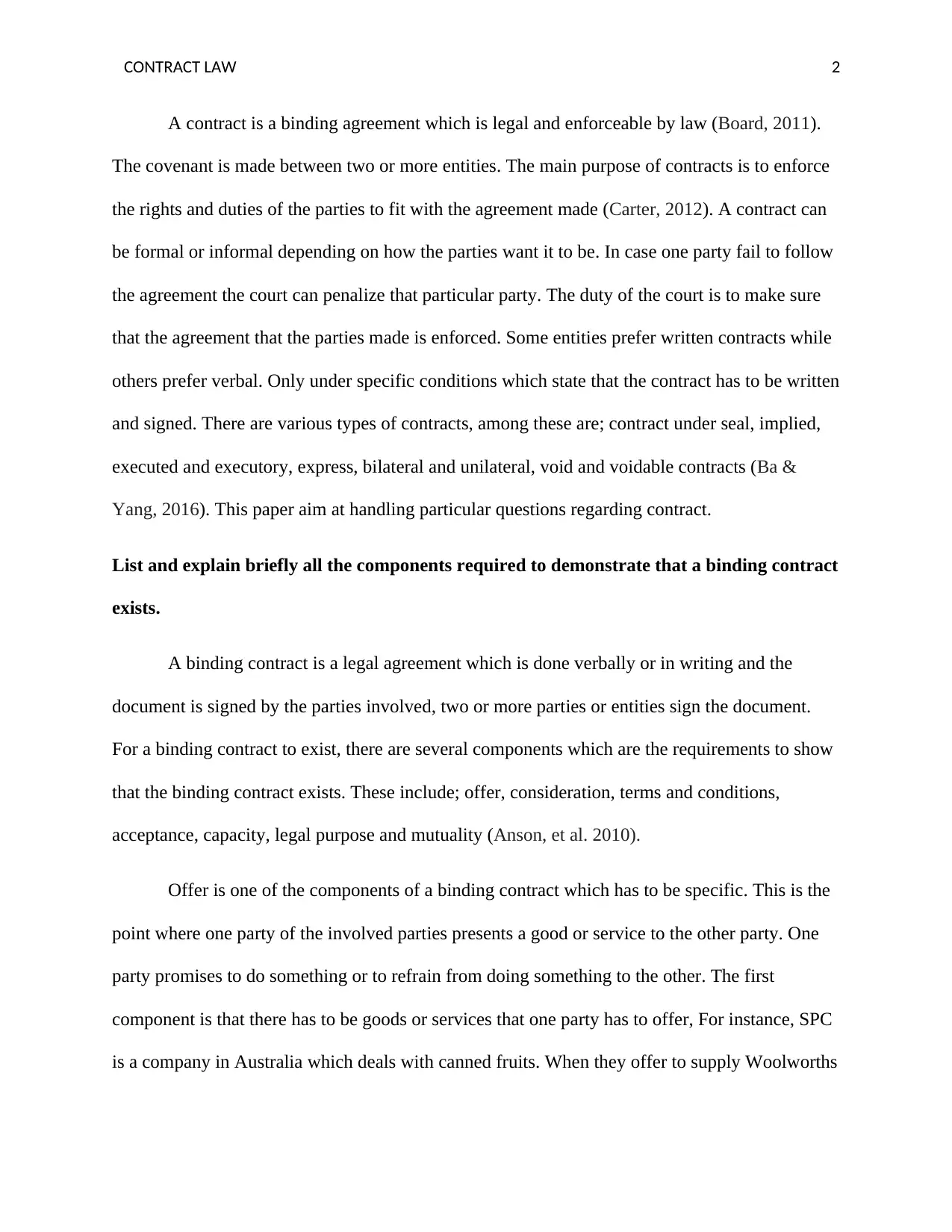
CONTRACT LAW 2
A contract is a binding agreement which is legal and enforceable by law (Board, 2011).
The covenant is made between two or more entities. The main purpose of contracts is to enforce
the rights and duties of the parties to fit with the agreement made (Carter, 2012). A contract can
be formal or informal depending on how the parties want it to be. In case one party fail to follow
the agreement the court can penalize that particular party. The duty of the court is to make sure
that the agreement that the parties made is enforced. Some entities prefer written contracts while
others prefer verbal. Only under specific conditions which state that the contract has to be written
and signed. There are various types of contracts, among these are; contract under seal, implied,
executed and executory, express, bilateral and unilateral, void and voidable contracts (Ba &
Yang, 2016). This paper aim at handling particular questions regarding contract.
List and explain briefly all the components required to demonstrate that a binding contract
exists.
A binding contract is a legal agreement which is done verbally or in writing and the
document is signed by the parties involved, two or more parties or entities sign the document.
For a binding contract to exist, there are several components which are the requirements to show
that the binding contract exists. These include; offer, consideration, terms and conditions,
acceptance, capacity, legal purpose and mutuality (Anson, et al. 2010).
Offer is one of the components of a binding contract which has to be specific. This is the
point where one party of the involved parties presents a good or service to the other party. One
party promises to do something or to refrain from doing something to the other. The first
component is that there has to be goods or services that one party has to offer, For instance, SPC
is a company in Australia which deals with canned fruits. When they offer to supply Woolworths
A contract is a binding agreement which is legal and enforceable by law (Board, 2011).
The covenant is made between two or more entities. The main purpose of contracts is to enforce
the rights and duties of the parties to fit with the agreement made (Carter, 2012). A contract can
be formal or informal depending on how the parties want it to be. In case one party fail to follow
the agreement the court can penalize that particular party. The duty of the court is to make sure
that the agreement that the parties made is enforced. Some entities prefer written contracts while
others prefer verbal. Only under specific conditions which state that the contract has to be written
and signed. There are various types of contracts, among these are; contract under seal, implied,
executed and executory, express, bilateral and unilateral, void and voidable contracts (Ba &
Yang, 2016). This paper aim at handling particular questions regarding contract.
List and explain briefly all the components required to demonstrate that a binding contract
exists.
A binding contract is a legal agreement which is done verbally or in writing and the
document is signed by the parties involved, two or more parties or entities sign the document.
For a binding contract to exist, there are several components which are the requirements to show
that the binding contract exists. These include; offer, consideration, terms and conditions,
acceptance, capacity, legal purpose and mutuality (Anson, et al. 2010).
Offer is one of the components of a binding contract which has to be specific. This is the
point where one party of the involved parties presents a good or service to the other party. One
party promises to do something or to refrain from doing something to the other. The first
component is that there has to be goods or services that one party has to offer, For instance, SPC
is a company in Australia which deals with canned fruits. When they offer to supply Woolworths
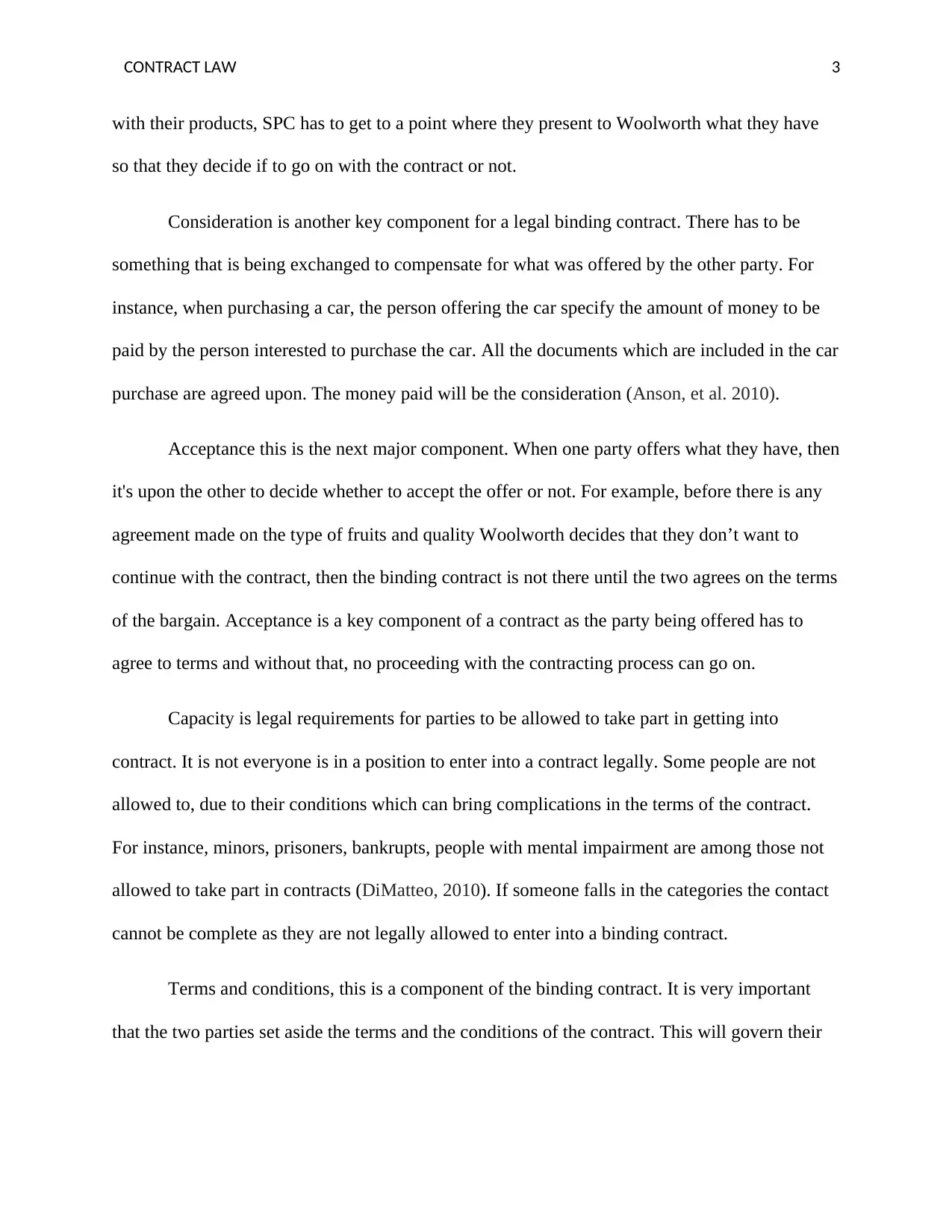
CONTRACT LAW 3
with their products, SPC has to get to a point where they present to Woolworth what they have
so that they decide if to go on with the contract or not.
Consideration is another key component for a legal binding contract. There has to be
something that is being exchanged to compensate for what was offered by the other party. For
instance, when purchasing a car, the person offering the car specify the amount of money to be
paid by the person interested to purchase the car. All the documents which are included in the car
purchase are agreed upon. The money paid will be the consideration (Anson, et al. 2010).
Acceptance this is the next major component. When one party offers what they have, then
it's upon the other to decide whether to accept the offer or not. For example, before there is any
agreement made on the type of fruits and quality Woolworth decides that they don’t want to
continue with the contract, then the binding contract is not there until the two agrees on the terms
of the bargain. Acceptance is a key component of a contract as the party being offered has to
agree to terms and without that, no proceeding with the contracting process can go on.
Capacity is legal requirements for parties to be allowed to take part in getting into
contract. It is not everyone is in a position to enter into a contract legally. Some people are not
allowed to, due to their conditions which can bring complications in the terms of the contract.
For instance, minors, prisoners, bankrupts, people with mental impairment are among those not
allowed to take part in contracts (DiMatteo, 2010). If someone falls in the categories the contact
cannot be complete as they are not legally allowed to enter into a binding contract.
Terms and conditions, this is a component of the binding contract. It is very important
that the two parties set aside the terms and the conditions of the contract. This will govern their
with their products, SPC has to get to a point where they present to Woolworth what they have
so that they decide if to go on with the contract or not.
Consideration is another key component for a legal binding contract. There has to be
something that is being exchanged to compensate for what was offered by the other party. For
instance, when purchasing a car, the person offering the car specify the amount of money to be
paid by the person interested to purchase the car. All the documents which are included in the car
purchase are agreed upon. The money paid will be the consideration (Anson, et al. 2010).
Acceptance this is the next major component. When one party offers what they have, then
it's upon the other to decide whether to accept the offer or not. For example, before there is any
agreement made on the type of fruits and quality Woolworth decides that they don’t want to
continue with the contract, then the binding contract is not there until the two agrees on the terms
of the bargain. Acceptance is a key component of a contract as the party being offered has to
agree to terms and without that, no proceeding with the contracting process can go on.
Capacity is legal requirements for parties to be allowed to take part in getting into
contract. It is not everyone is in a position to enter into a contract legally. Some people are not
allowed to, due to their conditions which can bring complications in the terms of the contract.
For instance, minors, prisoners, bankrupts, people with mental impairment are among those not
allowed to take part in contracts (DiMatteo, 2010). If someone falls in the categories the contact
cannot be complete as they are not legally allowed to enter into a binding contract.
Terms and conditions, this is a component of the binding contract. It is very important
that the two parties set aside the terms and the conditions of the contract. This will govern their
⊘ This is a preview!⊘
Do you want full access?
Subscribe today to unlock all pages.

Trusted by 1+ million students worldwide
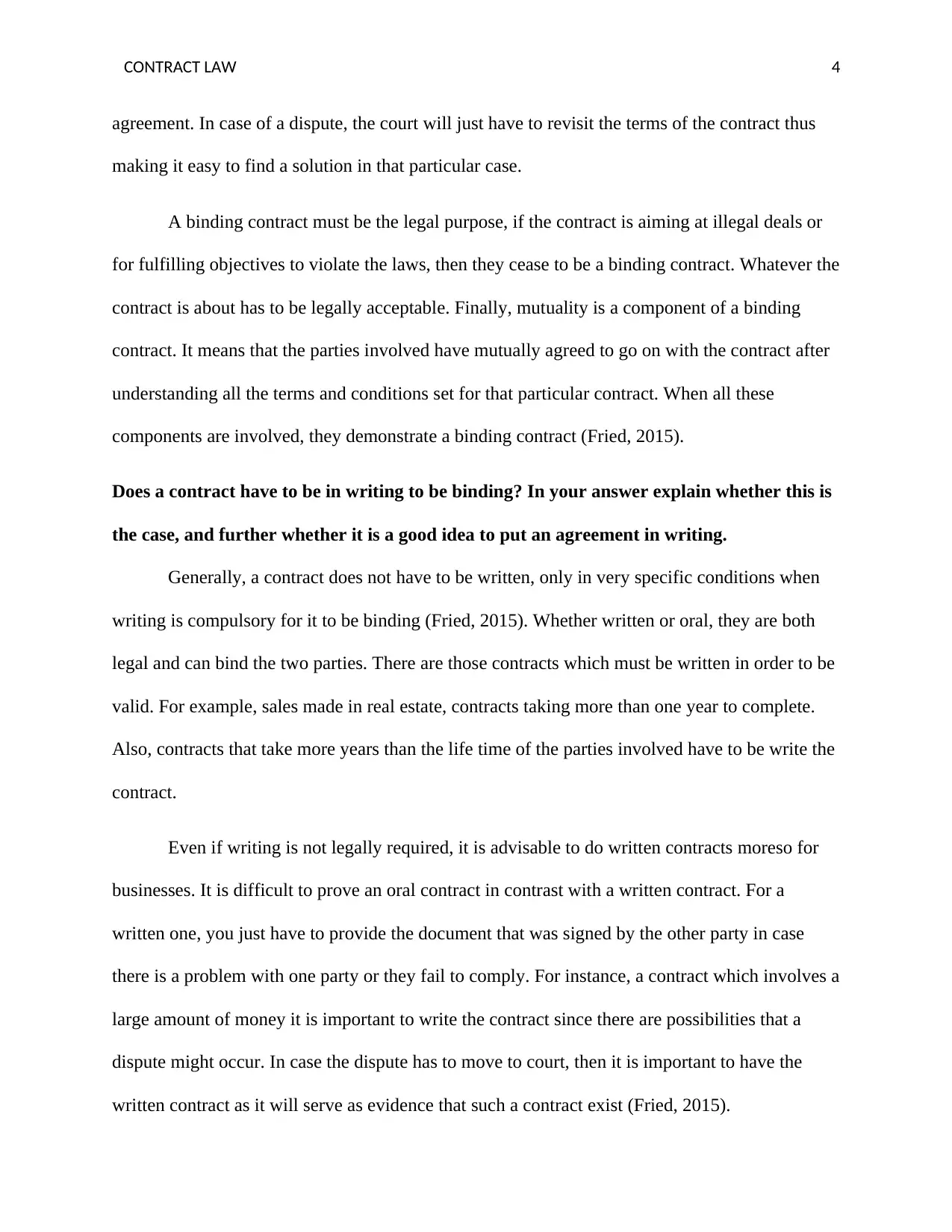
CONTRACT LAW 4
agreement. In case of a dispute, the court will just have to revisit the terms of the contract thus
making it easy to find a solution in that particular case.
A binding contract must be the legal purpose, if the contract is aiming at illegal deals or
for fulfilling objectives to violate the laws, then they cease to be a binding contract. Whatever the
contract is about has to be legally acceptable. Finally, mutuality is a component of a binding
contract. It means that the parties involved have mutually agreed to go on with the contract after
understanding all the terms and conditions set for that particular contract. When all these
components are involved, they demonstrate a binding contract (Fried, 2015).
Does a contract have to be in writing to be binding? In your answer explain whether this is
the case, and further whether it is a good idea to put an agreement in writing.
Generally, a contract does not have to be written, only in very specific conditions when
writing is compulsory for it to be binding (Fried, 2015). Whether written or oral, they are both
legal and can bind the two parties. There are those contracts which must be written in order to be
valid. For example, sales made in real estate, contracts taking more than one year to complete.
Also, contracts that take more years than the life time of the parties involved have to be write the
contract.
Even if writing is not legally required, it is advisable to do written contracts moreso for
businesses. It is difficult to prove an oral contract in contrast with a written contract. For a
written one, you just have to provide the document that was signed by the other party in case
there is a problem with one party or they fail to comply. For instance, a contract which involves a
large amount of money it is important to write the contract since there are possibilities that a
dispute might occur. In case the dispute has to move to court, then it is important to have the
written contract as it will serve as evidence that such a contract exist (Fried, 2015).
agreement. In case of a dispute, the court will just have to revisit the terms of the contract thus
making it easy to find a solution in that particular case.
A binding contract must be the legal purpose, if the contract is aiming at illegal deals or
for fulfilling objectives to violate the laws, then they cease to be a binding contract. Whatever the
contract is about has to be legally acceptable. Finally, mutuality is a component of a binding
contract. It means that the parties involved have mutually agreed to go on with the contract after
understanding all the terms and conditions set for that particular contract. When all these
components are involved, they demonstrate a binding contract (Fried, 2015).
Does a contract have to be in writing to be binding? In your answer explain whether this is
the case, and further whether it is a good idea to put an agreement in writing.
Generally, a contract does not have to be written, only in very specific conditions when
writing is compulsory for it to be binding (Fried, 2015). Whether written or oral, they are both
legal and can bind the two parties. There are those contracts which must be written in order to be
valid. For example, sales made in real estate, contracts taking more than one year to complete.
Also, contracts that take more years than the life time of the parties involved have to be write the
contract.
Even if writing is not legally required, it is advisable to do written contracts moreso for
businesses. It is difficult to prove an oral contract in contrast with a written contract. For a
written one, you just have to provide the document that was signed by the other party in case
there is a problem with one party or they fail to comply. For instance, a contract which involves a
large amount of money it is important to write the contract since there are possibilities that a
dispute might occur. In case the dispute has to move to court, then it is important to have the
written contract as it will serve as evidence that such a contract exist (Fried, 2015).
Paraphrase This Document
Need a fresh take? Get an instant paraphrase of this document with our AI Paraphraser
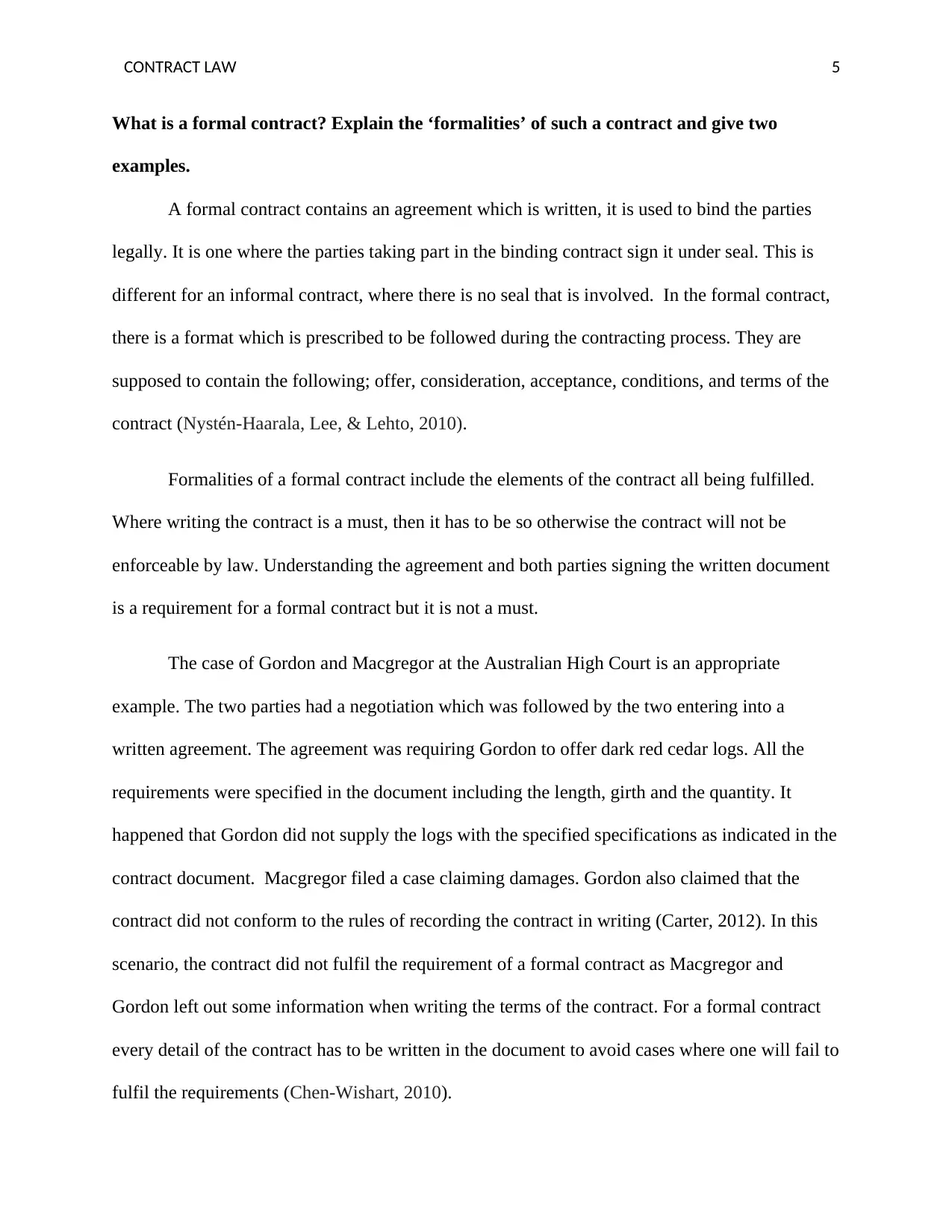
CONTRACT LAW 5
What is a formal contract? Explain the ‘formalities’ of such a contract and give two
examples.
A formal contract contains an agreement which is written, it is used to bind the parties
legally. It is one where the parties taking part in the binding contract sign it under seal. This is
different for an informal contract, where there is no seal that is involved. In the formal contract,
there is a format which is prescribed to be followed during the contracting process. They are
supposed to contain the following; offer, consideration, acceptance, conditions, and terms of the
contract (Nystén-Haarala, Lee, & Lehto, 2010).
Formalities of a formal contract include the elements of the contract all being fulfilled.
Where writing the contract is a must, then it has to be so otherwise the contract will not be
enforceable by law. Understanding the agreement and both parties signing the written document
is a requirement for a formal contract but it is not a must.
The case of Gordon and Macgregor at the Australian High Court is an appropriate
example. The two parties had a negotiation which was followed by the two entering into a
written agreement. The agreement was requiring Gordon to offer dark red cedar logs. All the
requirements were specified in the document including the length, girth and the quantity. It
happened that Gordon did not supply the logs with the specified specifications as indicated in the
contract document. Macgregor filed a case claiming damages. Gordon also claimed that the
contract did not conform to the rules of recording the contract in writing (Carter, 2012). In this
scenario, the contract did not fulfil the requirement of a formal contract as Macgregor and
Gordon left out some information when writing the terms of the contract. For a formal contract
every detail of the contract has to be written in the document to avoid cases where one will fail to
fulfil the requirements (Chen-Wishart, 2010).
What is a formal contract? Explain the ‘formalities’ of such a contract and give two
examples.
A formal contract contains an agreement which is written, it is used to bind the parties
legally. It is one where the parties taking part in the binding contract sign it under seal. This is
different for an informal contract, where there is no seal that is involved. In the formal contract,
there is a format which is prescribed to be followed during the contracting process. They are
supposed to contain the following; offer, consideration, acceptance, conditions, and terms of the
contract (Nystén-Haarala, Lee, & Lehto, 2010).
Formalities of a formal contract include the elements of the contract all being fulfilled.
Where writing the contract is a must, then it has to be so otherwise the contract will not be
enforceable by law. Understanding the agreement and both parties signing the written document
is a requirement for a formal contract but it is not a must.
The case of Gordon and Macgregor at the Australian High Court is an appropriate
example. The two parties had a negotiation which was followed by the two entering into a
written agreement. The agreement was requiring Gordon to offer dark red cedar logs. All the
requirements were specified in the document including the length, girth and the quantity. It
happened that Gordon did not supply the logs with the specified specifications as indicated in the
contract document. Macgregor filed a case claiming damages. Gordon also claimed that the
contract did not conform to the rules of recording the contract in writing (Carter, 2012). In this
scenario, the contract did not fulfil the requirement of a formal contract as Macgregor and
Gordon left out some information when writing the terms of the contract. For a formal contract
every detail of the contract has to be written in the document to avoid cases where one will fail to
fulfil the requirements (Chen-Wishart, 2010).
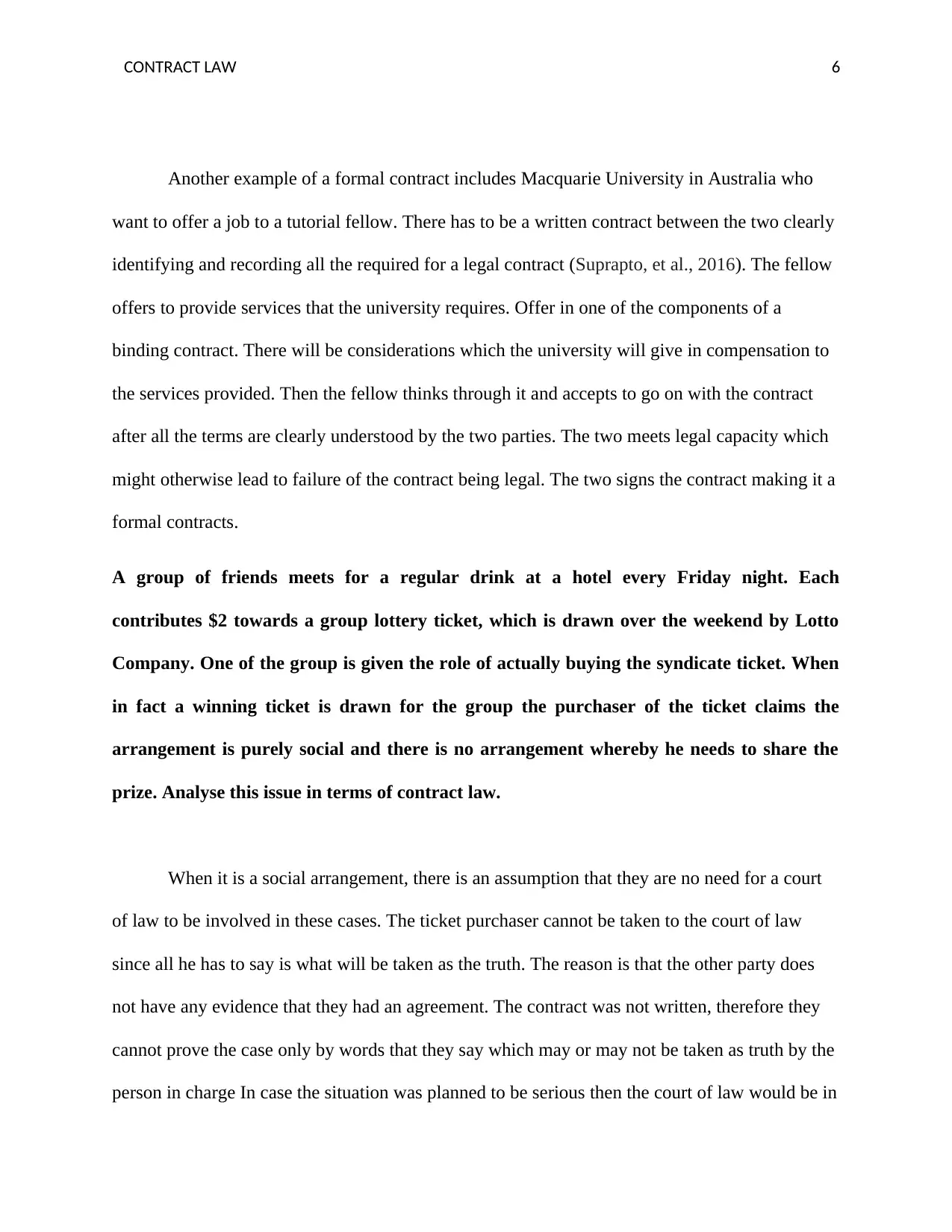
CONTRACT LAW 6
Another example of a formal contract includes Macquarie University in Australia who
want to offer a job to a tutorial fellow. There has to be a written contract between the two clearly
identifying and recording all the required for a legal contract (Suprapto, et al., 2016). The fellow
offers to provide services that the university requires. Offer in one of the components of a
binding contract. There will be considerations which the university will give in compensation to
the services provided. Then the fellow thinks through it and accepts to go on with the contract
after all the terms are clearly understood by the two parties. The two meets legal capacity which
might otherwise lead to failure of the contract being legal. The two signs the contract making it a
formal contracts.
A group of friends meets for a regular drink at a hotel every Friday night. Each
contributes $2 towards a group lottery ticket, which is drawn over the weekend by Lotto
Company. One of the group is given the role of actually buying the syndicate ticket. When
in fact a winning ticket is drawn for the group the purchaser of the ticket claims the
arrangement is purely social and there is no arrangement whereby he needs to share the
prize. Analyse this issue in terms of contract law.
When it is a social arrangement, there is an assumption that they are no need for a court
of law to be involved in these cases. The ticket purchaser cannot be taken to the court of law
since all he has to say is what will be taken as the truth. The reason is that the other party does
not have any evidence that they had an agreement. The contract was not written, therefore they
cannot prove the case only by words that they say which may or may not be taken as truth by the
person in charge In case the situation was planned to be serious then the court of law would be in
Another example of a formal contract includes Macquarie University in Australia who
want to offer a job to a tutorial fellow. There has to be a written contract between the two clearly
identifying and recording all the required for a legal contract (Suprapto, et al., 2016). The fellow
offers to provide services that the university requires. Offer in one of the components of a
binding contract. There will be considerations which the university will give in compensation to
the services provided. Then the fellow thinks through it and accepts to go on with the contract
after all the terms are clearly understood by the two parties. The two meets legal capacity which
might otherwise lead to failure of the contract being legal. The two signs the contract making it a
formal contracts.
A group of friends meets for a regular drink at a hotel every Friday night. Each
contributes $2 towards a group lottery ticket, which is drawn over the weekend by Lotto
Company. One of the group is given the role of actually buying the syndicate ticket. When
in fact a winning ticket is drawn for the group the purchaser of the ticket claims the
arrangement is purely social and there is no arrangement whereby he needs to share the
prize. Analyse this issue in terms of contract law.
When it is a social arrangement, there is an assumption that they are no need for a court
of law to be involved in these cases. The ticket purchaser cannot be taken to the court of law
since all he has to say is what will be taken as the truth. The reason is that the other party does
not have any evidence that they had an agreement. The contract was not written, therefore they
cannot prove the case only by words that they say which may or may not be taken as truth by the
person in charge In case the situation was planned to be serious then the court of law would be in
⊘ This is a preview!⊘
Do you want full access?
Subscribe today to unlock all pages.

Trusted by 1+ million students worldwide
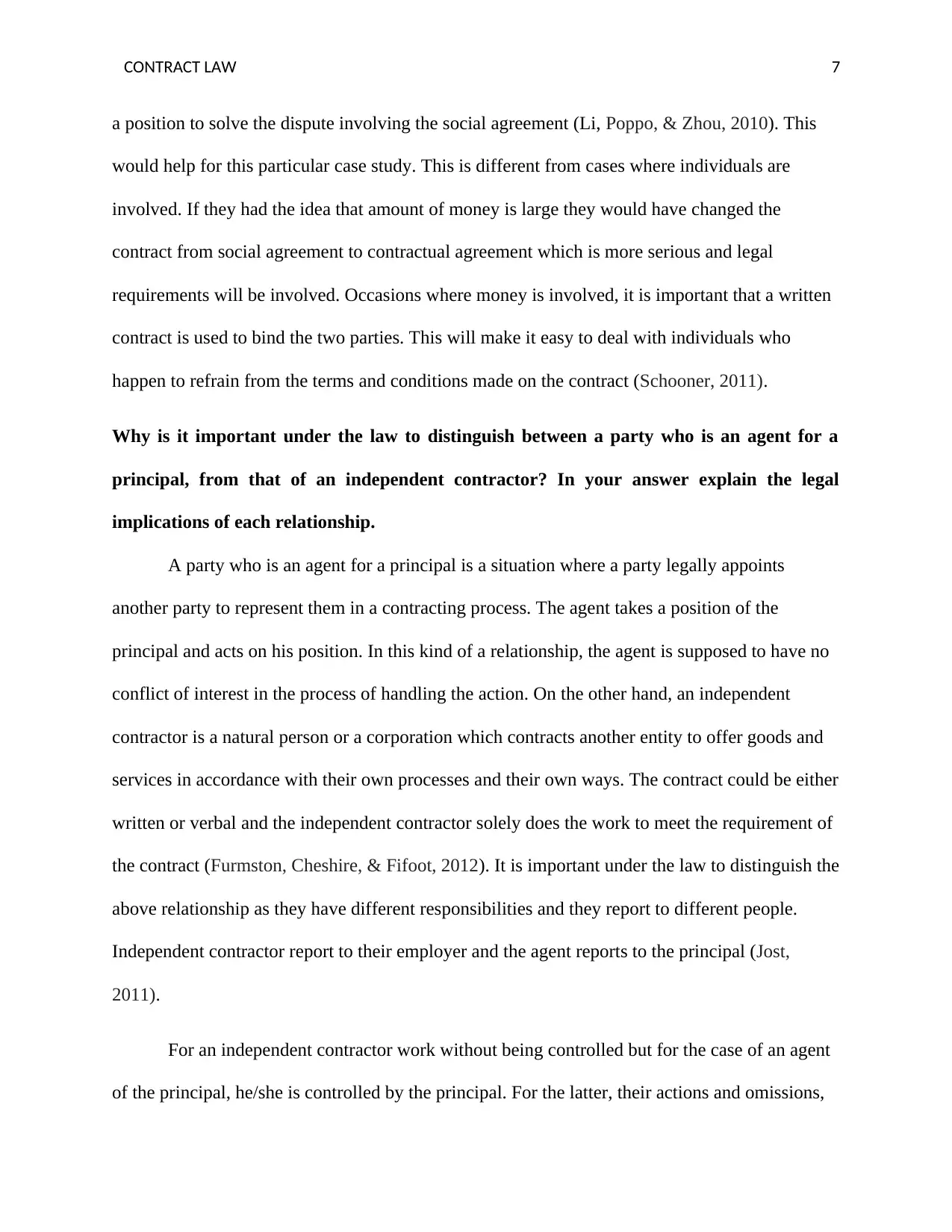
CONTRACT LAW 7
a position to solve the dispute involving the social agreement (Li, Poppo, & Zhou, 2010). This
would help for this particular case study. This is different from cases where individuals are
involved. If they had the idea that amount of money is large they would have changed the
contract from social agreement to contractual agreement which is more serious and legal
requirements will be involved. Occasions where money is involved, it is important that a written
contract is used to bind the two parties. This will make it easy to deal with individuals who
happen to refrain from the terms and conditions made on the contract (Schooner, 2011).
Why is it important under the law to distinguish between a party who is an agent for a
principal, from that of an independent contractor? In your answer explain the legal
implications of each relationship.
A party who is an agent for a principal is a situation where a party legally appoints
another party to represent them in a contracting process. The agent takes a position of the
principal and acts on his position. In this kind of a relationship, the agent is supposed to have no
conflict of interest in the process of handling the action. On the other hand, an independent
contractor is a natural person or a corporation which contracts another entity to offer goods and
services in accordance with their own processes and their own ways. The contract could be either
written or verbal and the independent contractor solely does the work to meet the requirement of
the contract (Furmston, Cheshire, & Fifoot, 2012). It is important under the law to distinguish the
above relationship as they have different responsibilities and they report to different people.
Independent contractor report to their employer and the agent reports to the principal (Jost,
2011).
For an independent contractor work without being controlled but for the case of an agent
of the principal, he/she is controlled by the principal. For the latter, their actions and omissions,
a position to solve the dispute involving the social agreement (Li, Poppo, & Zhou, 2010). This
would help for this particular case study. This is different from cases where individuals are
involved. If they had the idea that amount of money is large they would have changed the
contract from social agreement to contractual agreement which is more serious and legal
requirements will be involved. Occasions where money is involved, it is important that a written
contract is used to bind the two parties. This will make it easy to deal with individuals who
happen to refrain from the terms and conditions made on the contract (Schooner, 2011).
Why is it important under the law to distinguish between a party who is an agent for a
principal, from that of an independent contractor? In your answer explain the legal
implications of each relationship.
A party who is an agent for a principal is a situation where a party legally appoints
another party to represent them in a contracting process. The agent takes a position of the
principal and acts on his position. In this kind of a relationship, the agent is supposed to have no
conflict of interest in the process of handling the action. On the other hand, an independent
contractor is a natural person or a corporation which contracts another entity to offer goods and
services in accordance with their own processes and their own ways. The contract could be either
written or verbal and the independent contractor solely does the work to meet the requirement of
the contract (Furmston, Cheshire, & Fifoot, 2012). It is important under the law to distinguish the
above relationship as they have different responsibilities and they report to different people.
Independent contractor report to their employer and the agent reports to the principal (Jost,
2011).
For an independent contractor work without being controlled but for the case of an agent
of the principal, he/she is controlled by the principal. For the latter, their actions and omissions,
Paraphrase This Document
Need a fresh take? Get an instant paraphrase of this document with our AI Paraphraser
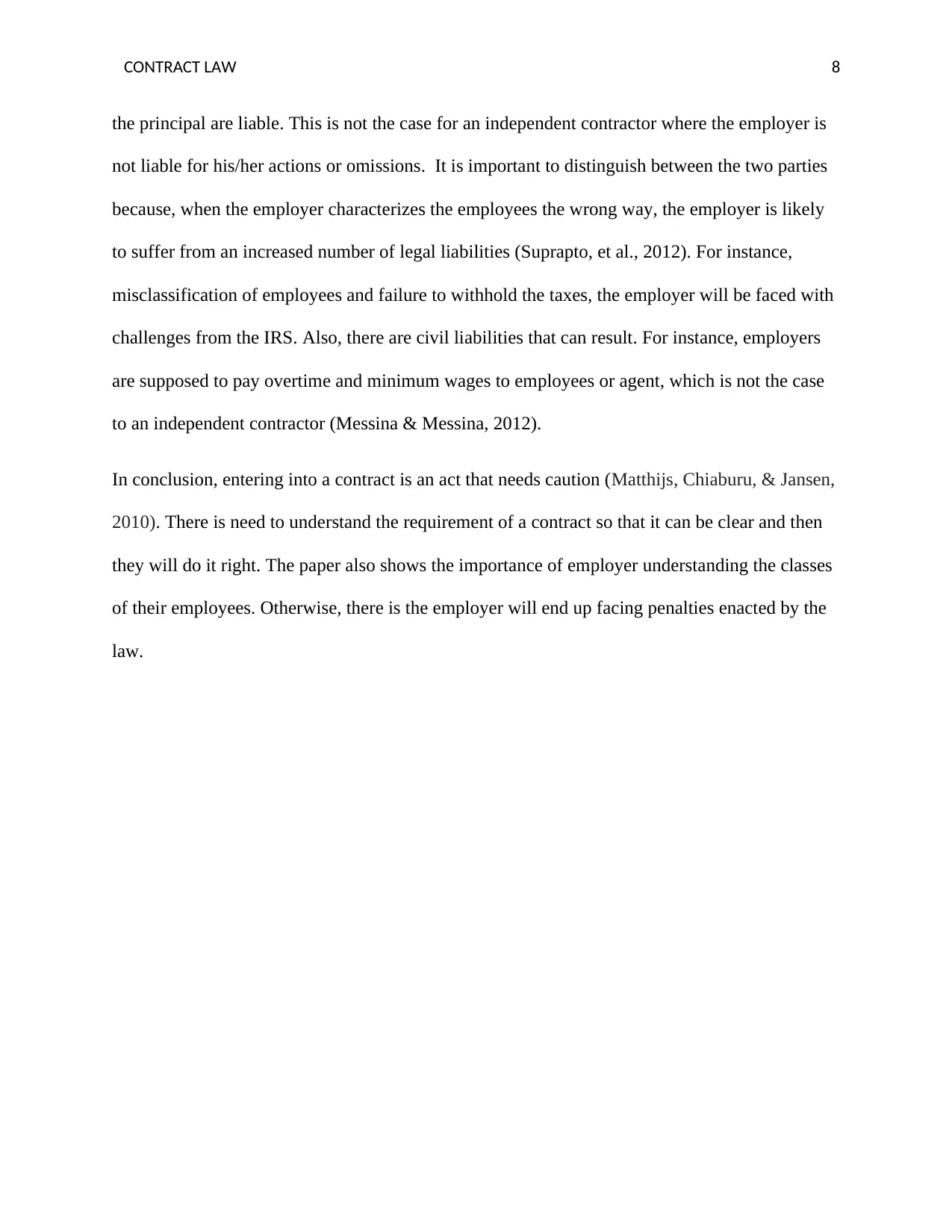
CONTRACT LAW 8
the principal are liable. This is not the case for an independent contractor where the employer is
not liable for his/her actions or omissions. It is important to distinguish between the two parties
because, when the employer characterizes the employees the wrong way, the employer is likely
to suffer from an increased number of legal liabilities (Suprapto, et al., 2012). For instance,
misclassification of employees and failure to withhold the taxes, the employer will be faced with
challenges from the IRS. Also, there are civil liabilities that can result. For instance, employers
are supposed to pay overtime and minimum wages to employees or agent, which is not the case
to an independent contractor (Messina & Messina, 2012).
In conclusion, entering into a contract is an act that needs caution (Matthijs, Chiaburu, & Jansen,
2010). There is need to understand the requirement of a contract so that it can be clear and then
they will do it right. The paper also shows the importance of employer understanding the classes
of their employees. Otherwise, there is the employer will end up facing penalties enacted by the
law.
the principal are liable. This is not the case for an independent contractor where the employer is
not liable for his/her actions or omissions. It is important to distinguish between the two parties
because, when the employer characterizes the employees the wrong way, the employer is likely
to suffer from an increased number of legal liabilities (Suprapto, et al., 2012). For instance,
misclassification of employees and failure to withhold the taxes, the employer will be faced with
challenges from the IRS. Also, there are civil liabilities that can result. For instance, employers
are supposed to pay overtime and minimum wages to employees or agent, which is not the case
to an independent contractor (Messina & Messina, 2012).
In conclusion, entering into a contract is an act that needs caution (Matthijs, Chiaburu, & Jansen,
2010). There is need to understand the requirement of a contract so that it can be clear and then
they will do it right. The paper also shows the importance of employer understanding the classes
of their employees. Otherwise, there is the employer will end up facing penalties enacted by the
law.
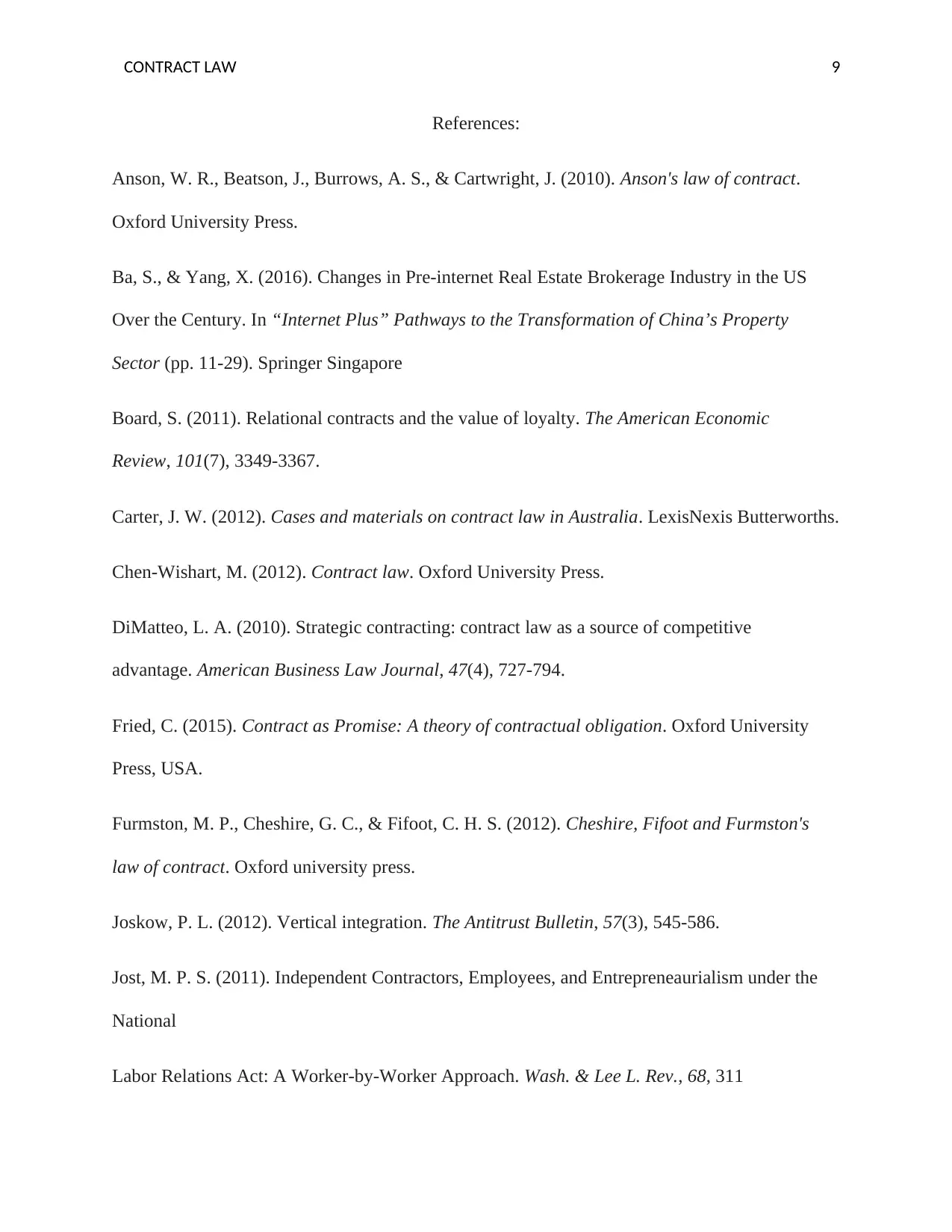
CONTRACT LAW 9
References:
Anson, W. R., Beatson, J., Burrows, A. S., & Cartwright, J. (2010). Anson's law of contract.
Oxford University Press.
Ba, S., & Yang, X. (2016). Changes in Pre-internet Real Estate Brokerage Industry in the US
Over the Century. In “Internet Plus” Pathways to the Transformation of China’s Property
Sector (pp. 11-29). Springer Singapore
Board, S. (2011). Relational contracts and the value of loyalty. The American Economic
Review, 101(7), 3349-3367.
Carter, J. W. (2012). Cases and materials on contract law in Australia. LexisNexis Butterworths.
Chen-Wishart, M. (2012). Contract law. Oxford University Press.
DiMatteo, L. A. (2010). Strategic contracting: contract law as a source of competitive
advantage. American Business Law Journal, 47(4), 727-794.
Fried, C. (2015). Contract as Promise: A theory of contractual obligation. Oxford University
Press, USA.
Furmston, M. P., Cheshire, G. C., & Fifoot, C. H. S. (2012). Cheshire, Fifoot and Furmston's
law of contract. Oxford university press.
Joskow, P. L. (2012). Vertical integration. The Antitrust Bulletin, 57(3), 545-586.
Jost, M. P. S. (2011). Independent Contractors, Employees, and Entrepreneaurialism under the
National
Labor Relations Act: A Worker-by-Worker Approach. Wash. & Lee L. Rev., 68, 311
References:
Anson, W. R., Beatson, J., Burrows, A. S., & Cartwright, J. (2010). Anson's law of contract.
Oxford University Press.
Ba, S., & Yang, X. (2016). Changes in Pre-internet Real Estate Brokerage Industry in the US
Over the Century. In “Internet Plus” Pathways to the Transformation of China’s Property
Sector (pp. 11-29). Springer Singapore
Board, S. (2011). Relational contracts and the value of loyalty. The American Economic
Review, 101(7), 3349-3367.
Carter, J. W. (2012). Cases and materials on contract law in Australia. LexisNexis Butterworths.
Chen-Wishart, M. (2012). Contract law. Oxford University Press.
DiMatteo, L. A. (2010). Strategic contracting: contract law as a source of competitive
advantage. American Business Law Journal, 47(4), 727-794.
Fried, C. (2015). Contract as Promise: A theory of contractual obligation. Oxford University
Press, USA.
Furmston, M. P., Cheshire, G. C., & Fifoot, C. H. S. (2012). Cheshire, Fifoot and Furmston's
law of contract. Oxford university press.
Joskow, P. L. (2012). Vertical integration. The Antitrust Bulletin, 57(3), 545-586.
Jost, M. P. S. (2011). Independent Contractors, Employees, and Entrepreneaurialism under the
National
Labor Relations Act: A Worker-by-Worker Approach. Wash. & Lee L. Rev., 68, 311
⊘ This is a preview!⊘
Do you want full access?
Subscribe today to unlock all pages.

Trusted by 1+ million students worldwide
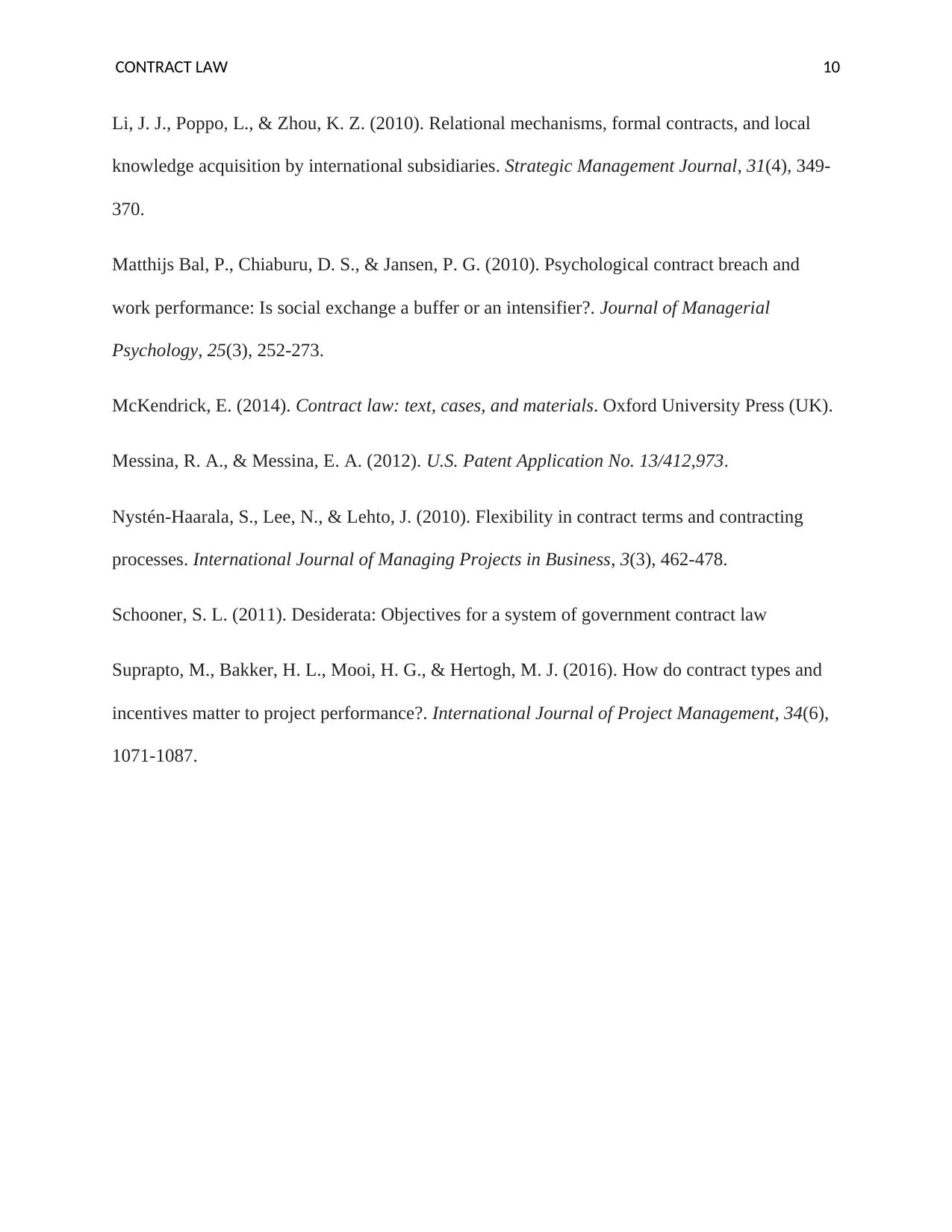
CONTRACT LAW 10
Li, J. J., Poppo, L., & Zhou, K. Z. (2010). Relational mechanisms, formal contracts, and local
knowledge acquisition by international subsidiaries. Strategic Management Journal, 31(4), 349-
370.
Matthijs Bal, P., Chiaburu, D. S., & Jansen, P. G. (2010). Psychological contract breach and
work performance: Is social exchange a buffer or an intensifier?. Journal of Managerial
Psychology, 25(3), 252-273.
McKendrick, E. (2014). Contract law: text, cases, and materials. Oxford University Press (UK).
Messina, R. A., & Messina, E. A. (2012). U.S. Patent Application No. 13/412,973.
Nystén-Haarala, S., Lee, N., & Lehto, J. (2010). Flexibility in contract terms and contracting
processes. International Journal of Managing Projects in Business, 3(3), 462-478.
Schooner, S. L. (2011). Desiderata: Objectives for a system of government contract law
Suprapto, M., Bakker, H. L., Mooi, H. G., & Hertogh, M. J. (2016). How do contract types and
incentives matter to project performance?. International Journal of Project Management, 34(6),
1071-1087.
Li, J. J., Poppo, L., & Zhou, K. Z. (2010). Relational mechanisms, formal contracts, and local
knowledge acquisition by international subsidiaries. Strategic Management Journal, 31(4), 349-
370.
Matthijs Bal, P., Chiaburu, D. S., & Jansen, P. G. (2010). Psychological contract breach and
work performance: Is social exchange a buffer or an intensifier?. Journal of Managerial
Psychology, 25(3), 252-273.
McKendrick, E. (2014). Contract law: text, cases, and materials. Oxford University Press (UK).
Messina, R. A., & Messina, E. A. (2012). U.S. Patent Application No. 13/412,973.
Nystén-Haarala, S., Lee, N., & Lehto, J. (2010). Flexibility in contract terms and contracting
processes. International Journal of Managing Projects in Business, 3(3), 462-478.
Schooner, S. L. (2011). Desiderata: Objectives for a system of government contract law
Suprapto, M., Bakker, H. L., Mooi, H. G., & Hertogh, M. J. (2016). How do contract types and
incentives matter to project performance?. International Journal of Project Management, 34(6),
1071-1087.
1 out of 10
Related Documents
Your All-in-One AI-Powered Toolkit for Academic Success.
+13062052269
info@desklib.com
Available 24*7 on WhatsApp / Email
![[object Object]](/_next/static/media/star-bottom.7253800d.svg)
Unlock your academic potential
Copyright © 2020–2025 A2Z Services. All Rights Reserved. Developed and managed by ZUCOL.




